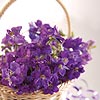From being used as a fragrance in incense sticks, pot pouri and perfumes to being used in cooking; flavouring with lavender can be limited only by one’s imagination.
 Lavender belongs to the herb family. Hence it should not come as a surprise that this lovely flower is used abundantly as a spice in food preparations. It extends a sweet, floral taste that has undertones of a slight citrus, lemon flavour. The potency of the flower increases with the drying.The plant can be used completely: flowers, leaves, buds and the stems. Lavender is a member of the mint family and is a close relative of thyme, rosemary and sage. It makes a great accompaniment to ingredients such as fennel and oregano. Lavender has been a documented herb for centuries. The pretty purple flower was used by the Egyptians for mummification. Arabs used it as a scent; while Greeks and the Romans bathed in lavender scented water. The word lavo in Latin means 'to wash', thus, the herb's name was derived.
Lavender belongs to the herb family. Hence it should not come as a surprise that this lovely flower is used abundantly as a spice in food preparations. It extends a sweet, floral taste that has undertones of a slight citrus, lemon flavour. The potency of the flower increases with the drying.The plant can be used completely: flowers, leaves, buds and the stems. Lavender is a member of the mint family and is a close relative of thyme, rosemary and sage. It makes a great accompaniment to ingredients such as fennel and oregano. Lavender has been a documented herb for centuries. The pretty purple flower was used by the Egyptians for mummification. Arabs used it as a scent; while Greeks and the Romans bathed in lavender scented water. The word lavo in Latin means 'to wash', thus, the herb's name was derived.
Lavender spread across Europe through Greece. Around 600 BC this lovely spice, made its way from the Greek Hyeres Islands into France, Spain, Italy and England where it became popular.
Queen Elizabeth I of England valued lavender tremendously. She is said to have commanded that the royal table never remain without lavender and her gardeners grew fresh flowers all year round. She consumed a regular amount of lavender tea to ease her migraines and she also used it as a body perfume.
However, it was Queen Victoria of England who was instrumental in making lavender popular. It was placed in every room of her palace. It was also used to wash the flooring, clean furniture, freshen the air and strewn amongst her linen!
Lavender washes were used during the times of the World War when injured soldiers had their wounds cleaned with lavender - scented water.
To this day, the French send lamb into meadows of lavender with the belief that lamb feeding on the flowers will give tender and juicy meat.
The flowers of the plant go well with champagne, chocolate cake or as a mere garnish for sorbets or ice-cream. Lavender also lends itself to wine based sauces or stews as well as custards.
It has medicinal uses as well.
An infusion of lavender can soothe and heal insect bites. Like neem, bunches of lavender are hung to ward off insects. Oil made from dried flowers help soothe headaches if applied to the temples. It is also regarded as a sleeping aid.
Three flower heads, added to a cup of boiling water makes for a soothing and relaxing bedtime drink.
It is believed that lavender oil, in the ratio of 1:10 with rosewater or witch hazel can be used as a treatment for acne and skin burns. However, one should use caution for sometimes this oil can cause allergies specially in pregnant and lactating women.
Lavender Sorbet
Makes 8-10 servings
Ingredients:
1 cup sugar
2 cups water
1 tbsp culinary lavender flowers
2 ½ tbsp freshly squeezed
lemon juice
2 tbsp vodka
Method:
In a medium saucepan over medium heat, combine sugar and water until the sugar dissolves. Add the lavender flowers; stir until mixture comes to a boil; reduce heat to low and simmer 5 minutes. Remove from heat, cover, and let it stand for approximately 10 minutes.
Place a fine strainer over a large bowl and pour syrup mixture through (straining out the lavender flowers). Add lemon juice and vodka to the strained syrup mixture; stir until thoroughly blended.
(Adding alcohol into a sorbet, keeps it soft. Since alcohol does not freeze, it doesn't allow the sorbet to freeze either. Vodka is excellent to use as it does not ruin the taste of the sorbet.) Transfer mixture to ice cream maker, process according to the manufacturer's instructions.
Pour the mixture into a container, cover, and place mixture in the freezer. When it is semi-solid, mash it up with a fork and refreeze again. When frozen, place in a food processor or blender and process until smooth. Cover and refreeze until serving time.
The sorbet can be prepared three days in advance.
Fresh Lemon and Lavender Ice Cream
Ingredients:
3/4 cups granulated sugar
2 lemons, zested
1/2 cup fresh lavender or 1/4 cup dried lavender
2 cups whole milk
2 cups heavy cream
8 egg yolks
12 thin slices fresh lemon
12 small sprigs fresh lavender
Method:
In a saucepan, combine lemon zest, lavender, milk, and cream. Bring to a boil. Steep for 20 minutes. Strain the mixture. Whisk the egg yolks and sugar together. Whisk 1 cup of the hot cream into the egg mixture. Mix thoroughly. In a steady stream, slowly add the egg mixture to the hot cream mixture. Continue to cook for 4 minutes, stirring occasionally. Remove from the heat and cool completely. Strain the mixture. Add it to the electric ice cream maker. Process according to manufacturers' directions.
Lavender Cookies
Makes 2 dozen cookies
Ingredients:
1 tbsp dried culinary lavender flowers
1 cup butter, room temperature
2/3 cup sugar
¼ tbsp lemon extract
½ tbsp vanilla extract
2 cups all purpose flour
Salt to taste
Method:
In a mortar, grind lavender flowers with the pestle. In a medium bowl, cream together ground lavender flowers, butter, sugar, vanilla extract and lemon extract. Add flour and salt; mix until combined (dough should be soft but not sticky). Refrigerate for one to two hours or until dough is firm.
Preheat oven to 325 degrees F. Remove dough from refrigerator. On a lightly floured surface, roll dough approximately 1/4-inch thick. Cut into desired shapes with cookie cutters and place onto ungreased cookie sheets. Bake 12 to 15 minutes or until cookies are lightly browned around the edges. Remove from oven and cool on wire racks.



 Lavender, The Queen’s Choice
Lavender, The Queen’s Choice

 Lavender belongs to the herb family. Hence it should not come as a surprise that this lovely flower is used abundantly as a spice in food preparations. It extends a sweet, floral taste that has undertones of a slight citrus, lemon flavour. The potency of the flower increases with the drying.The plant can be used completely: flowers, leaves, buds and the stems. Lavender is a member of the mint family and is a close relative of thyme, rosemary and sage. It makes a great accompaniment to ingredients such as fennel and oregano. Lavender has been a documented herb for centuries. The pretty purple flower was used by the Egyptians for mummification. Arabs used it as a scent; while Greeks and the Romans bathed in lavender scented water. The word lavo in Latin means 'to wash', thus, the herb's name was derived.
Lavender belongs to the herb family. Hence it should not come as a surprise that this lovely flower is used abundantly as a spice in food preparations. It extends a sweet, floral taste that has undertones of a slight citrus, lemon flavour. The potency of the flower increases with the drying.The plant can be used completely: flowers, leaves, buds and the stems. Lavender is a member of the mint family and is a close relative of thyme, rosemary and sage. It makes a great accompaniment to ingredients such as fennel and oregano. Lavender has been a documented herb for centuries. The pretty purple flower was used by the Egyptians for mummification. Arabs used it as a scent; while Greeks and the Romans bathed in lavender scented water. The word lavo in Latin means 'to wash', thus, the herb's name was derived.

